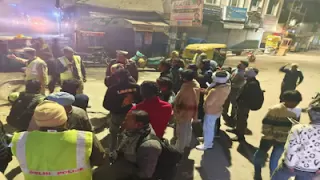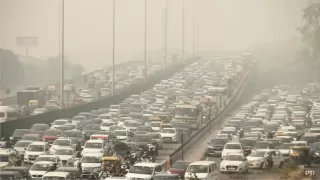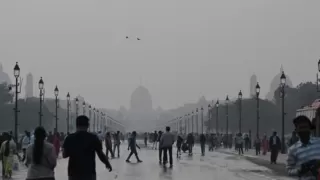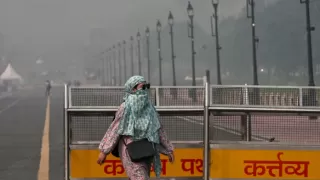The India Meteorological Department (IMD) has confirmed that the deep-depression over the southeast Bay of Bengal is intensifying and is expected to evolve into the cyclonic storm named Cyclone Montha by late Monday. The system is projected to strengthen further into a severe cyclonic storm and make landfall on the Andhra Pradesh coast by Tuesday, October 28 — potentially the first cyclone of the year to hit the Indian mainland.
According to IMD bulletins, the system is tracking west-northwestwards and was last reported several hundred kilometres southeast of the Andhra coast. Wind speeds are forecast to reach 90–100 km/h with gusts up to about 110 km/h, while sea conditions will deteriorate significantly. Coastal Andhra, Tamil Nadu, Odisha and adjoining interiors are being asked to brace for heavy rainfall, high tides and very rough seas.
Meteorological evolution & forecast track
The system developed from a well-marked low over the southeast Bay of Bengal and progressed to depression and deep-depression stages before intensifying into a cyclonic storm. As it traverses the warm waters of the southwest and adjoining west-central Bay of Bengal, the cyclone is expected to gain strength and reach peak intensity shortly before landfall.
Landfall is being projected between the coastal stretch of Machilipatnam and Kalingapatnam, near Kakinada, on the evening or night of October 28. Post-landfall, the cyclone is expected to weaken gradually as it moves inland towards interior Odisha and Chhattisgarh. Coastal low-lying stretches could witness storm surges of 0.5–1.2 metres around the time of landfall.
Impact, rainfall outlook & affected regions
The IMD has issued red and orange alerts for numerous districts along the east coast. Very heavy rainfall (115–210 mm in 24 hours) is likely in pockets of Rayalaseema, coastal Andhra and adjoining regions, while heavy to very heavy rain is expected across coastal Andhra, Yanam, parts of Tamil Nadu, southern Odisha, Telangana and Chhattisgarh until October 30.
Severe weather hazards include coastal inundation, widespread waterlogging in urban low-lying areas, flash floods in vulnerable catchments, and landslides in hilly terrain. Transport — road, rail and air — is likely to be disrupted in affected districts and essential services may be temporarily impacted.
State preparedness & administrative measures
State governments along the projected path have convened high-level preparedness meetings and placed district administrations on alert. Relief shelters have been identified and stocked with food, water, medicines and bedding. Evacuation of vulnerable populations from low-lying islands and flood-prone hamlets has been ordered in several coastal mandals.
Schools and colleges in many affected districts have been closed as a precaution. Control rooms are active at district and state levels to co-ordinate rescue, relief and restoration. Power, water and telecom agencies have been asked to pre-position repair teams to restore services quickly after the storm passes.
Search, rescue & medical readiness
National and state disaster-response teams including NDRF and SDRF units have been pre-positioned for rapid deployment. The Navy and Coast Guard are on high alert to assist in evacuations at sea or in isolated coastal pockets. Hospitals-on-wheels and temporary medical camps are being readied near vulnerable coastal towns to handle any surge in medical emergencies.
Public health teams have been instructed to prepare for vector-borne disease prevention and post-flood sanitation. Immunisation, emergency obstetric care and cold-chain preservation of essential vaccines have been included in the preparedness checklist.
Agricultural & economic impacts
Heavy rains and flooding during the cyclone window pose a serious threat to standing crops, particularly paddy and other rabi preparations in low-lying fields. Agricultural departments have issued advisories on draining stagnant water, early harvesting where feasible and crop protection measures to limit disease and pest outbreaks after excessive rains.
Supply-chain disruptions — affecting foodgrain movement, fuel distribution and retail logistics — are possible in the immediate aftermath. Authorities are arranging buffer stocks and alternate supply routes to maintain essential services in impacted districts.
Marine warnings & fishermen advisories
Sea conditions along the Andhra, Yanam and Odisha coasts are forecast to be rough to very rough and escalate to extremely high near the time of landfall. Port authorities have hoisted danger signals, shipping movements have been curtailed, and all fishing activity in the warned zones has been suspended until further notice.
Fisherfolk have been asked to return to safe harbours and follow Coast Guard and local administration advisories strictly. Casualties and loss of small craft are a major risk in such fast-developing coastal storms if warnings are not heeded.
Infrastructure & utilities response
Electricity distribution companies have mobilised restoration crews and spare transformers; water-supply agencies are securing pumping stations; and telecom companies are bolstering their on-ground teams to repair network outages. Road-clearance equipment has been readied to remove debris and fallen trees to reopen arterial routes as soon as conditions permit.
Bridge and embankment monitoring has been intensified in vulnerable districts to detect early signs of structural stress or washouts, and temporary traffic restrictions may be enforced on vulnerable stretches during the peak period.
Historical context & past cyclones
Andhra Pradesh’s coastline has previously borne the brunt of powerful October cyclones such as Titli (2018), Hudhud (2014) and Ogni (2006), which caused extensive damage to lives, homes, infrastructure and agriculture. Those events underline the importance of early warnings, timely evacuations and well-coordinated relief operations to reduce mortality and economic loss.
Lessons from previous cyclones — such as pre-emptive evacuations, rapid restoration protocols and community preparedness — are being applied to enhance the current response and to ensure quicker recovery post-landfall.
What residents should do — public safety advisory
Authorities advise the public to stay indoors during peak storm hours, avoid travel unless absolutely necessary, move to higher ground if located in low-lying areas, and avoid beaches, estuaries and riverbanks. Switch off electrical mains where flooding is imminent, store drinking water and essential medicines, and keep emergency contact numbers handy.
Follow official IMD bulletins and local administration or district control-room messages for timely instructions on evacuation, shelter locations and relief assistance. Do not attempt travel during heavy rainfall or overtopping of roads and bridges.
What to watch — monitoring & next updates
The cyclone’s exact intensity and track may still vary depending on upper-air conditions and sea-surface temperatures; consequently, IMD will continue to issue regular bulletins. The next 24–48 hours are critical for final landfall intensity and timing, and citizens are advised to monitor official updates frequently.
After landfall, the immediate priorities will shift to search-and-rescue, restoration of essential services, damage assessment and agricultural relief. Multi-agency coordination between central and state authorities will determine the speed and effectiveness of recovery operations.
Closing note
Cyclone Montha presents a rapidly evolving threat to India’s east coast. Preparedness actions taken now — evacuations, sheltering, pre-positioning relief stocks and ensuring communication — can significantly reduce loss and suffering. Residents and authorities in the warned districts should treat advisories seriously, cooperate with disaster-response teams and prioritise safety until the storm threat has fully passed.
Also Read: Supreme Court Summons States Over Delay in Stray Dog Rules


























